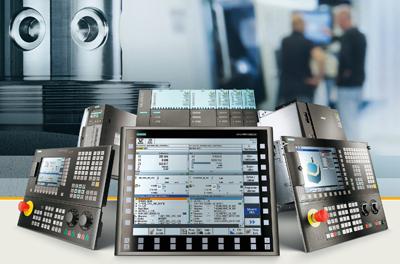
For the aerospace market, the Sinumerik 840D sl from Siemens Industry Inc. offers CNC technology that reportedly increases machine tool performance and user productivity. The 840D sl is a universal and flexible CNC system based upon the Sinamics S120 drive platform that can be used for up to 31 axes. It is a distributed, scalable, open and interconnecting system offering a wide range of specialized functions for milling, drilling, turning, grinding, handling and robotics technologies. It offers users innovative features that increase productivity on the manufacturing floor, especially the challenging aerospace segments of high-speed and five-axis machining.
For the job shop, the Sinumerik 828D numerical control is an ideal CNC solution for mid-range machine tools. It is designed to address the needs of complex milling and turning machines in the job shop segment by combining CNC, PLC, operator panel and axis control for six CNC measurement circuits into a single, robust operator panel.
The 828D is capable of full graphical, high-level language command and supports ISO programming that is customary in the United States. Programming time can be further reduced for small-batch production with the use of the ShopMill and ShopTurn graphical workstep programming system, while high-level language programming can be used in conjunction with programGuide to significantly reduce programming times for large-scale serial production.
With the introduction of the Sinumerik 828D, extensive online help animations and a new type of input prompting system with moving picture sequences provide the basis for exceptional user convenience. USB, Compact Flash (CF) card and Ethernet ports enable high-speed data transfers onto storage media or integration of the control system into corporate networks.
Recently introduced to the American machine tool industry, and based upon the new Sinumerik Operate graphical user interface, SinuTrain is the ideal solution for control identical CNC training.
With SinuTrain, actual NC programs are developed and simulated, to speed the program generation protocol. In this manner, machine tool operators not only learn the control language commands, but they also visualize part programs on a PC screen that are identical to the machine tool's screen. As an additional benefit, programs generated through SinuTrain can then be used on actual machines.
Offered in several languages, SinuTrain is available for different needs and budgets including a trial version, a study version, a single-user license and an educational license.
Contact Details
Related Glossary Terms
- computer numerical control ( CNC)
computer numerical control ( CNC)
Microprocessor-based controller dedicated to a machine tool that permits the creation or modification of parts. Programmed numerical control activates the machine’s servos and spindle drives and controls the various machining operations. See DNC, direct numerical control; NC, numerical control.
- flash
flash
Thin web or film of metal on a casting that occurs at die partings and around air vents and movable cores. This excess metal is due to necessary working and operating clearances in a die. Flash also is the excess material squeezed out of the cavity as a compression mold closes or as pressure is applied to the cavity.
- gang cutting ( milling)
gang cutting ( milling)
Machining with several cutters mounted on a single arbor, generally for simultaneous cutting.
- grinding
grinding
Machining operation in which material is removed from the workpiece by a powered abrasive wheel, stone, belt, paste, sheet, compound, slurry, etc. Takes various forms: surface grinding (creates flat and/or squared surfaces); cylindrical grinding (for external cylindrical and tapered shapes, fillets, undercuts, etc.); centerless grinding; chamfering; thread and form grinding; tool and cutter grinding; offhand grinding; lapping and polishing (grinding with extremely fine grits to create ultrasmooth surfaces); honing; and disc grinding.
- milling
milling
Machining operation in which metal or other material is removed by applying power to a rotating cutter. In vertical milling, the cutting tool is mounted vertically on the spindle. In horizontal milling, the cutting tool is mounted horizontally, either directly on the spindle or on an arbor. Horizontal milling is further broken down into conventional milling, where the cutter rotates opposite the direction of feed, or “up” into the workpiece; and climb milling, where the cutter rotates in the direction of feed, or “down” into the workpiece. Milling operations include plane or surface milling, endmilling, facemilling, angle milling, form milling and profiling.
- numerical control ( NC)
numerical control ( NC)
Any controlled equipment that allows an operator to program its movement by entering a series of coded numbers and symbols. See CNC, computer numerical control; DNC, direct numerical control.
- numerical control ( NC)2
numerical control ( NC)
Any controlled equipment that allows an operator to program its movement by entering a series of coded numbers and symbols. See CNC, computer numerical control; DNC, direct numerical control.
- robotics
robotics
Discipline involving self-actuating and self-operating devices. Robots frequently imitate human capabilities, including the ability to manipulate physical objects while evaluating and reacting appropriately to various stimuli. See industrial robot; robot.
- turning
turning
Workpiece is held in a chuck, mounted on a face plate or secured between centers and rotated while a cutting tool, normally a single-point tool, is fed into it along its periphery or across its end or face. Takes the form of straight turning (cutting along the periphery of the workpiece); taper turning (creating a taper); step turning (turning different-size diameters on the same work); chamfering (beveling an edge or shoulder); facing (cutting on an end); turning threads (usually external but can be internal); roughing (high-volume metal removal); and finishing (final light cuts). Performed on lathes, turning centers, chucking machines, automatic screw machines and similar machines.

